Title search results
Showing 1 - 20 of 2747 items
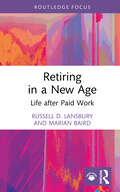
Retiring in a New Age: Life after Paid Work (Routledge Focus on Business and Management)
By Marian Baird, Russell D. Lansbury. 2026
This book examines the concept of retirement, how it has changed, and what the future holds for the next generation…
of retirees.The book analyses government data and university surveys of more than 1,000 retirees in Australia and 4,000 retirees in Sweden, as well as in-depth interviews with retirees in each country. It demonstrates that while both countries have differences in their retirement policies and practices, as well as the outcomes for retirees, the process of retirement is undergoing change in both countries as people retire at a range of ages, but often then re-enter the workforce for various reasons. The book proposes four distinctive post-retirement orientations: Stayers, Leavers, Blenders and Disengaged retirees. It then discusses how individuals, employers and governments are responding to the challenges of ‘retiring in a new age’, suggesting policies and a new social contract for retirees that addresses their needs for economic security, physical and mental health, as well as engagement with the wider community.A book of keen interest to scholars of employment and work relations, human resource management, as well as labour economics. Policymakers and students interested in employment issues that affect economic and social equality will also find the book’s framework fit for use. A full set of interview transcripts and discussion questions is available on the Routledge webpage for download: www.routledge.com/9781041118329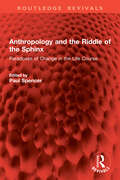
Originally published in 1990, Anthropology and the Riddle of the Sphinx: Paradoxes of Change in the Life Course, seeks to…
relate the problems of maturation and ageing to the life course as a whole. As it is treated here, the riddle posed by the sphinx asks ‘What is it that changes as we age?’ and is concerned with the enigmas of this total process. Ultimately, the ways in which we experience these problems stem from our view of ageing and the contradictions of society itself.The essays in this volume consider aspects of this problem with reference to a variety of cultures. The young, the mature, and the elderly have distinctive identities, but they form a continuum whose profile is culturally constructed.Anthropology and the Riddle of the Sphinx: Paradoxes of Change in the Life Course is intended as a contribution to the growing literature on ageing, deliberately broadening the topic in the search for a wider understanding. This volume aims to stimulate interest in neglected aspects of the ageing process within social anthropology and to present an anthropological point of view to others who have an interest in problems associated with the life course. It will be of particular value to the students of social anthropology and medical sociology.It was originally published as part of the ASA Monographs series: https://www.routledge.com/ASA-Monographs/book-series/SE0127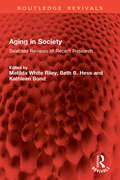
Aging in Society: Selected Reviews of Recent Research (Routledge Revivals)
By Beth B. Hess, Matilda White Riley, Kathleen Bond. 1983
Originally published in 1983, Aging in Society consists of a selection of papers that were prepared by various authors as…
background papers for the 1981 White House Conference on Aging. The papers provided an overview of knowledge on various aspects of aging in the United States at the time. Topics covered include aging and the family, economic aspects of an aging population, recent trends in the geographical distribution of the elderly population and mortality and health differentials by sex. Today it can be read in its historical context.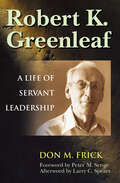
Robert K. Greenleaf: A Life of Servant Leadership
By Don M. Frick. 2004
Thousands if not millions of people have heard the term “servant leadership,” introduced by Robert K. Greenleaf in his landmark…
essay The Servant as Leader, published in 1970. There are now Centers for Servant Leadership in ten countries and counting. His work is regularly cited by some of the most prominent business writers and leaders in the world, such as Ken Blanchard, Stephen Covey, Peter Senge, Margaret Wheatley, and Peter Block. And yet until now there has been no biography of the man who first developed this revolutionary idea. Don Frick was given unfettered access to all of Greenleaf’s papers and correspondence. The result is a fascinating book that details the sources of Greenleaf’s thought, describes his friendships with dozens of well-known people, and shows how he influenced business history well before his first book was published at the age of 73, and lived his own life as a servant leader. As Director of Management Research at AT&T for 38 years, Greenleaf was known as “AT&T’s Kept Revolutionary.” Among other unusual initiatives, he oversaw a novel program which taught executive decision making through great literature, established the first corporate assessment center using knowledge gleaned from the OSS’s approach to training civilian spies during World War II, and invited leading philosophers and theologians to have conversations with AT&T executives. After a period of soul searching and some surprising experiments in consciousness, Greenleaf retired from AT&T and began to develop the concept of servant leadership, the then-heretical notion that leaders lead best by serving their followers rather than “commanding” them. He continued to promote the idea through teaching, writing, and consulting until his last years, and was instrumental in creating a score of important organizations such as The Center for Creative Leadership and Yokefellow Institute. Always, Greenleaf was a seeker opening himself up to novel experiences and astonishing people. He was a complex person—an introvert who served in public roles, a wise person who refused to give others “The Answer,” a brilliant thinker who often declared, “I am not a scholar.” His grave carries the epitaph he wrote for himself: “Potentially a good plumber; ruined by a sophisticated education.”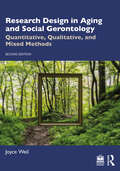
This comprehensive book provides a review across methodological approaches and data-collection methods commonly used with older adults in real-life settings.…
It addresses the role of normative age-related sensory, cognitive, and functional changes, as well as the influence of generational cohort (age-period-cohort).Fully updated, this second edition reflects recent changes in gerontology and includes more information about equity, diversity and inclusion; the impact of the COVID-19 pandemic; the use of virtual research methods; discussion about the researcher’s reflexivity; the role of theory in research; qualitative research developments; an expansion of secondary analysis of data;and the use of artificial intelligence in research.Features include: Descriptions, evaluations, and applications of a wide range of methodological approaches and methods used to collect data about older persons (quantitative, qualitative, mixed, and emergent methods: photovoice, virtual environments, etc.) Ways to match research questions to selection of method without a preconceived methodological preference or dominance Real-world and applied examples along with cases from the gerontological literature "How to" sections about reading output/software reports and qualitative-analysis screenshots (from NVivo) and quantitative (SPSS) output and interpretation Pedagogical tools in every chapter such as text boxes, case studies, definitions of key terms, discussion questions, and references for further reading on chapter topics Glossary of key terms, complete sample research report, and an overview of past methodological research design work in gerontology This text is intended for upper-level undergraduates and masters students in aging and gerontology as well as students in human development, applied anthropology, psychology, public health, sociology, and social work settings. Healthcare professionals, social workers, and care managers who work with older adults will also find this text a valuable resource.At www.routledge.com/cw/weil instructors will find PowerPoint presentations, additional discussion questions, suggestions for in-class activities and assessments and a sample syllabus; and students will find flashcards based on glossary terms, a downloadable copy of the sample research report in the text, links to data sets, related websites, online videos and podcasts, further reading, select gerontological journals and multiple choice and true or false questions.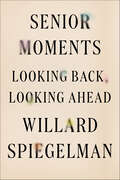
Senior Moments: Looking Back, Looking Ahead
By Willard Spiegelman. 2016
A moving collection of essays on aging and happinessDrawing on more than six decades' worth of lessons from his storied…
career as a writer and professor, Willard Spiegelman reflects with candid humor and sophistication on growing old. Senior Moments is a series of discrete essays that, when taken together, constitute the life of a man who, despite Western cultural notions of aging as something to be denied, overcome, and resisted, has continued to relish the simplest of pleasures: reading, looking at art, talking, and indulging in occasional fits of nostalgia while also welcoming what inevitably lies ahead. Spiegelman's expertly crafted book considers, with wisdom and elegance, how to be alert to the joys that brim from unexpected places even as death draws near. Senior Moments is a foray into the felicity and follies that age brings; a consideration of how and what one reads or rereads in late adulthood; the eagerness for, and disappointment in, long-awaited reunions, at which the past comes alive in the present. A clear-eyed book of memories, written in eight searching and courageously honest essays, Senior Moments is guaranteed to stimulate, stir, and restore.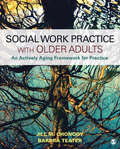
Social Work Practice With Older Adults: An Actively Aging Framework for Practice
By Jill M. Chonody, Barbra A. Teater. 2018
Social Work Practice With Older Adults by Jill Chonody and Barbra Teater presents a contemporary framework based on the World…
Health Organization’s active aging policy that allows forward-thinking students to focus on client strengths and resources when working with the elderly. The Actively Aging framework takes into account health, social, behavioral, economic, and personal factors as they relate to aging, but also explores environmental issues, which supports the new educational standards put forth by the Council on Social Work Education. Covering micro, mezzo, and macro practice domains, the text examines all aspects of working with aging populations, from assessment through termination.
Social Work Practice With Older Adults: An Actively Aging Framework for Practice
By Jill M. Chonody, Barbra A. Teater. 2018
Social Work Practice With Older Adults by Jill Chonody and Barbra Teater presents a contemporary framework based on the World…
Health Organization’s active aging policy that allows forward-thinking students to focus on client strengths and resources when working with the elderly. The Actively Aging framework takes into account health, social, behavioral, economic, and personal factors as they relate to aging, but also explores environmental issues, which supports the new educational standards put forth by the Council on Social Work Education. Covering micro, mezzo, and macro practice domains, the text examines all aspects of working with aging populations, from assessment through termination.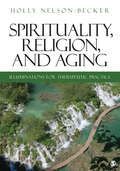
Spirituality, Religion, and Aging: Illuminations for Therapeutic Practice
By Holly B. Nelson-Becker. 2018
This highly integrative book was written for students, professionals in aging, religious leaders, and older adults themselves. Readers will gain the knowledge…
and skills they need to assess, engage, and address the spiritual and religious needs of older persons. Taking a fresh approach that breaks new ground in the field, the author discusses eight major world religions and covers values and ethics, theories, interventions, health and caregiving, depression and anxiety, dementia, and the end of life. Meditations and exercises throughout the book allow readers to expand and explore their personal understanding of spirituality. Referencing the latest research, the book includes assessments and skill-based tools designed to help practitioners enhance the mental health of older people.
Spirituality, Religion, and Aging: Illuminations for Therapeutic Practice
By Holly B. Nelson-Becker. 2018
This highly integrative book was written for students, professionals in aging, religious leaders, and older adults themselves. Readers will gain the knowledge…
and skills they need to assess, engage, and address the spiritual and religious needs of older persons. Taking a fresh approach that breaks new ground in the field, the author discusses eight major world religions and covers values and ethics, theories, interventions, health and caregiving, depression and anxiety, dementia, and the end of life. Meditations and exercises throughout the book allow readers to expand and explore their personal understanding of spirituality. Referencing the latest research, the book includes assessments and skill-based tools designed to help practitioners enhance the mental health of older people.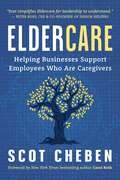
Eldercare: Helping Businesses Support Employees Who Are Caregivers
By Scot Cheben. 2025
In today's multigenerational workforce, supporting employee caregivers isn't just compassionate-it's essential for sustainability and success.When your employees assume caregiving roles…
outside of the workplace, it affects staff retention and attention, and therefore, your bottom line. As more and more people live longer and with myriad health limitations, many businesses have failed to keep pace. It's imperative to put proper infrastructure in place to support caregiving employees. Eldercare: Helping Businesses Support Employees Who Are Caregivers seeks to help employers cope with the complex situations arising for those who need to care for their aging loved ones. It offers practical advice, including: Why it is important for businesses to know the facts about caregiving The financial effects for employees The rules and guidelines of the Family and Medical Leave Act (FMLA) How your business can help its employees External help and resources Safeguard employee retention and a healthy workplace culture while ensuring continued profitability by providing resources and benefits to your caregiving employees. Help them manage the overwhelm of balancing caregiving and work, and you will both thrive.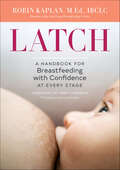
Latch: A Handbook for Breastfeeding with Confidence at Every Stage
By Robin Kaplan. 2018
Latch is a judgment-free guide to breastfeeding that will teach you exactly what you need to know to meet your…
own personal breastfeeding goals.Early motherhood is a time of great joy. It can also be filled with new stressors—chief among them: breastfeeding. In Latch: A Handbook for Breastfeeding with Confidence at Every Stage, International Board-Certified Lactation Consultant, Robin Kaplan, addresses specific breastfeeding concerns, allowing you to feel empowered while breastfeeding and overcome challenges as they arise. After working with countless mothers who have felt unique in their breastfeeding challenges, and as the mother of two who overcame breastfeeding challenges of her own, she knows how deeply personal breastfeeding is.Compassionate and supportive, Latch covers the most pressing topics at each stage of breastfeeding and will teach you to:Establish successful breastfeeding early on with attention to breastfeeding positions, latch, mom's wellbeing, milk supply, supplementation, and pumpingBreastfeed through lifestyle changes such as returning to work, transitioning to bottle-feeding, supplementation, reducing nighttime feedings, and introducing solidsWean your baby/toddler from breastfeeding including emotional preparation, reducing feedings, and guidance for when your child tries to nurse againComplete with breastfeeding stories from new moms, breastmilk storage guidelines, and resources for additional breastfeeding support Latch will be there for you, holding your hand, every step of the way.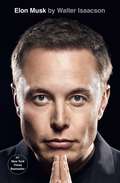
Elon Musk
By Walter Isaacson. 2023
The #1 New York Times and global bestseller from Walter Isaacson—the acclaimed author of Steve Jobs, Einstein: His Life and…
World, Benjamin Franklin, and Leonardo da Vinci—is the astonishingly intimate story of the most fascinating, controversial innovator of modern times. For two years, Isaacson shadowed Elon Musk as he executed his vision for electric vehicles at Tesla, space exploration with SpaceX, the AI revolution, and the takeover of Twitter and its conversion to X. The result is the definitive portrait of the mercurial pioneer that offers clues to his political instincts, future ambitions, and overall worldview. When Elon Musk was a kid in South Africa, he was regularly beaten by bullies. One day a group pushed him down some concrete steps and kicked him until his face was a swollen ball of flesh. He was in the hospital for a week. But the physical scars were minor compared to the emotional ones inflicted by his father, an engineer, rogue, and charismatic fantasist. His father&’s impact on his psyche would linger. He developed into a tough yet vulnerable man-child, prone to abrupt Jekyll-and-Hyde mood swings, with an exceedingly high tolerance for risk, a craving for drama, an epic sense of mission, and a maniacal intensity that was callous and at times destructive. At the beginning of 2022—after a year marked by SpaceX launching thirty-one rockets into orbit, Tesla selling a million cars, and him becoming the richest man on earth—Musk spoke ruefully about his compulsion to stir up dramas. &“I need to shift my mindset away from being in crisis mode, which it has been for about fourteen years now, or arguably most of my life,&” he said. It was a wistful comment, not a New Year&’s resolution. Even as he said it, he was secretly buying up shares of Twitter, the world&’s ultimate playground. Over the years, whenever he was in a dark place, his mind went back to being bullied on the playground. Now he had the chance to own the playground. For two years, Isaacson shadowed Musk, attended his meetings, walked his factories with him, and spent hours interviewing him, his family, friends, coworkers, and adversaries. The result is the revealing inside story, filled with amazing tales of triumphs and turmoil, that addresses the question: are the demons that drive Musk also what it takes to drive innovation and progress?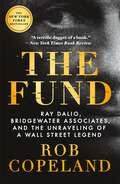
The Fund: Ray Dalio, Bridgewater Associates, and the Unraveling of a Wall Street Legend
By Rob Copeland. 2023
The unauthorized, unvarnished story of famed Wall Street hedge-fund manager Ray Dalio. An instant New York Times bestseller!Ray Dalio does…
not want you to read this book.When the billionaire founder of Bridgewater Associates, the largest hedge fund on the planet, announced in 2022 that he was stepping down from the company he started out of his apartment nearly 50 years ago, the news made headlines around the world. Dalio cultivated an aura of international admiration and fame thanks to his company’s eye-popping success, coupled with a mystique he encouraged with frequent media appearances, celebrity hobnobbing, and his bestselling book, Principles. In The Fund, award-winning New York Times journalist Rob Copeland punctures this carefully-constructed narrative of the benevolent business titan, exposing his much-promoted “principles” as one of the great feats of hubris in modern memory—in practice, they encouraged a toxic culture of paranoia and backstabbing.The Fund is a page-turning, stranger-than-fiction journey into a rarefied world of wealth and power. It offers an unflinching look at the pain so often caused by the “radical transparency” Dalio has described as a core tenet of his recipe for business success and a meaningful life. Drawing on hundreds of interviews with those inside and around the firm, Copeland takes readers into the room as former FBI director Jim Comey kisses Dalio's ring, recent Pennsylvania Senate candidate David McCormick drinks the Kool-Aid, and a rotating cast of memorable characters grapple with their personal psychological and moral limits—all under the watchful eye of their charismatic leader. This is a cautionary tale for anyone convinced that the ability to make lots of money has anything at all to do with unlocking the principles of human nature.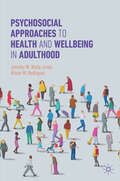
Psychosocial Approaches to Health and Wellbeing in Adulthood
By Jennifer M. Waite-Jones, Alison M. Rodriguez. 2025
This textbook provides an up-to-date guide to theories within psychology and sociology relevant to understanding the major life transitions within…
adulthood and older age and demonstrates how they can be applied in practice. In doing so, it offers a psychosocial approach that will equip readers to meet the combined physical, psychological and social needs of those in their care. In this book the impact of biological factors on adult experience is acknowledged alongside a careful exploration of the socially constructed nature of different stages of adulthood across the lifespan. In its analysis of developmental stages, the book covers key issues of current concern including emerging and early adulthood, &‘the sandwich generation&’ (those caring for both their children and their parents), later life, medicalisation, neurodiversity, long term and degenerative conditions, bereavement, and grief. Both vulnerabilities and ways to enhance resilience encouraging healthy ageing are examined. Utilising practice-oriented case studies and reflective questions it illustrates how psychosocial perspectives may be applied within family, workplace, health, and social care contexts. It offers under graduate and graduate students of social work, nursing, mental health, education, psychology, human development, gerontology and ageing, the tools needed to evaluate the interlocking psychosocial factors influencing the lives of adults at different stages of life.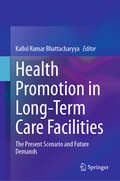
Health Promotion in Long-Term Care Facilities: The Present Scenario and Future Demands
By Kallol Kumar Bhattacharyya. 2025
This book discusses biopsychosocial barriers and facilitators of long-term care services, focusing on health promotional activities targeted to maximize quality…
of life. This knowledge of meaningful activities helps to identify and improve strategies for supporting people living in long-term care facilities with various chronic disorders at a deeper level. Although no all-encompassing theory of caregiving has yet been developed, this book explores various theoretical formulations as central aspects of promoting health in long-term care practices. The current culture change in long-term care controls the well-being of the concerned person physically, psychologically, socially, and economically. In later life, these issues profoundly impact individuals' morbidity and lifespan. Further, it has been evidenced that the Centers for Medicare & Medicaid Services' five-star rating system that provides long-term care facilities&’ quality information to the public does not fully represent what matters to the residents from their perspectives. Resident satisfaction is an integral part of the quality of care; instead of clinical quality measures only, it is influenced by residents, their family members, staff, and administration. Person-centered care not only requires a 'culture change' in how residents and caregivers work together, but it also requires facilities to ensure staff deliver care with the highest possible level of empathy and adopt meaningful care practices. Among the topics covered in this contributed volume: Are Quality of Care and Quality of Life Synonymous in Long-Term Care? Aging-in-Place or Long-Term Care? Changing the Narrative to Promote Aging in Place in Long-Term Care Person-Centered Care and Culture Change Movement in Long-Term Care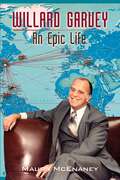
Willard Garvey: An Epic Life
By Maura McEnaney. 2013
Pulitzer Prize–winning journalist Maura McEnaney&’s fascinating and wide-ranging biography of businessman and entrepreneur Willard Garvey is, in many ways, a…
history of 20th-century America itself.Born in Dust Bowl country, as a teenager he rode the rails at the height of the Great Depression to work in California&’s Grapes of Wrath orchards. He sailed on the Queen Mary to the European theater of World War II, where he was one of the first three American officers into Berlin following its fall, and attended the Potsdam Conference. A visionary businessman who dreamed of &“Every man a homeowner,&” Garvey pioneered affordable home ownership in developing countries at a time when few if any knew or cared about the millions living in slums worldwide. Despite revolutions, coups, and Anti-American persecution, his World Homes provided thousands of families in countries from South America to Asia the opportunity of moving onto and up the economic ladder. He hobnobbed with heads of state and captains of industry, counting 20th century titans J.B. Fuqua, Robert Galvin, and John Templeton as closest friends and confidantes. He started a short-lived fourth television network, and pushed for independent journalism in an era of tightly-controlled media. He even tried to start a new country. Yet despite his far-flung operations, Garvey was never far from his hometown affairs. Organizing and hosting Saturday morning coffee-shop gatherings of ordinary concerned citizens, inveterate writer of Letters to the Editor, crusader against the overreach of government bureaucracy, Garvey ceaselessly fought for his fellow man to have the opportunities for success he had enjoyed and that he saw government&’s growing powers threatening. It is perhaps his final &“biggest&” achievement that stands as Willard Garvey&’s legacy. Beyond owner-operator of the &“world&’s largest&” grain elevator, and &“largest private landowner in Nevada&”: builder of Kansas&’s tallest building—the Epic Center. Its slanted copper roof pointed to the sky, it echoes the Kansas state motto that could well serve as his, too: Ad Astra per Aspera, &“To the stars, through difficulties.&”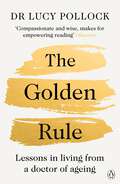
A new way to think about ageing - for ourselves and the people we love. With warmth and wisdom, geriatrician…
Dr Lucy Pollock shows us how'The Golden Rule is part manifesto for better integration and appreciation between generations, and part reflection on a career spent looking after our elders, [. . .] with good humour, sanity, wisdom and quite a few jokes' The Times__Plan A: stay young foreverPlan B: read this bookToday, we are living longer lives and have choices now as never before about how we will age.What will make us happy?What frightens us, and what might allay our fears?What changes, made right now, will help us to flourish?In The Golden Rule, Dr Lucy Pollock shares lessons she has learned in the thirty years of working with older people and their family and friends.She explores problems that can be fixed with tests and tablets, and problems that require a different sort of medicine.These engrossing stories explain what she has been taught about impossible families, important decisions, becoming older without children, sexuality, race, love, and living with uncertainty.--'From the first pages, the impression you have is how much you’d want Pollock as your medical practitioner. . . this warm and compassionate book is part reflection, part rallying cry to set in place a better society for older people' Daily Mail'Beautiful and wise, filled with characters I know living through situations I recognise, filtered through the kindness of thoughtful storytelling' Kathryn Mannix, author of With the End in Mind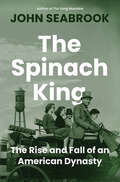
The Spinach King: The Rise and Fall of an American Dynasty
By John Seabrook. 2025
The riveting saga of the Seabrook Family, by one of The New Yorker’s most acclaimed storytellers. “Having left this material…
for his writer son, my father must have wanted the story told, even if he couldn’t bear to tell it himself.” So begins the story of a forgotten American dynasty, a farming family from the bean fields of southern New Jersey who became as wealthy and powerful as aristocrats—only to implode in a storm of lies. The patriarch, C. F. Seabrook, was hailed as the “Henry Ford of Agriculture.” His son Jack, a keen businessman, was poised to take over what Life called “the biggest vegetable factory on earth.” But the carefully cultivated facade—glamorous outings by horse-drawn carriage, hidden wine cellars, and movie star girlfriends—hid dark secrets that led to the implosion of the family business. At the heart of the narrative is a multi-generational succession battle. It’s a tale of family secrets and Swiss bank accounts, of half-truths, of hatred and passion—and lots and lots of liquor. The Seabrooks’ colorful legal and moral failings took place amid the trappings of extraordinary privilege. But the story of where that money came from is not so pretty They say behind every great fortune there is a great crime. At Seabrook Farms, the troubling American histories of race, immigration, and exploitation arise like weeds from the soil. Great Migration Black laborers struck against the company for better wages in the 1930s, and Japanese Americans helped found a “global village” on the farm after World War II. Revealing both C. F. and Jack Seabrook’s corruption, The Spinach King undermines the “great man” theory of industrial progress. It also shows how American farms evolved from Jeffersonian smallholdings to gigantic agribusinesses, and what such enormous firms do to the families whose fate is bound up in the land. A compulsively readable story of class and privilege, betrayal and revenge—three decades in the making—The Spinach King explores the author’s complicated family legacy and the dark corners of the American Dream.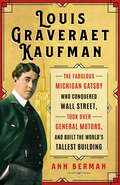
Discover the extraordinary rise of a glamorous and significant American banking titan. This fascinating biography recounts the life and legacy…
of a titan of American banking, Louis Graveraet Kaufman (1870–1942). Also known as LG, he was a Gatsbyesque figure born in Michigan's Upper Peninsula who married into great wealth and then amassed far more of his own. Under LG, New York's Chatham Phenix National Bank and Trust Company became one of the nation's largest banks and the first in New York to boast a network of branches. When he was denied entry into the exclusive, Protestant, old-money Huron Mountain Club, LG responded by building his own retreat: the world's largest log lodge, a 26,000-square-foot behemoth near Marquette, Michigan. Christened Granot Loma, it became the site of lavish Prohibition-era parties, attracting many celebrities who came in private rail cars to enjoy jazz and liquor chez Kaufman. A darling of the press, LG became a household name, making news by coordinating the famous takeover of General Motors in 1916, narrowly escaping death in the Wall Street Bombing of 1920, and financing the Empire State Building during the Great Depression. Author Ann Berman highlights Kaufman's remarkable journey from "barefoot boy" to trailblazing branch banking giant, proving LG was not just a man of his time but one worth reading about over a century later.